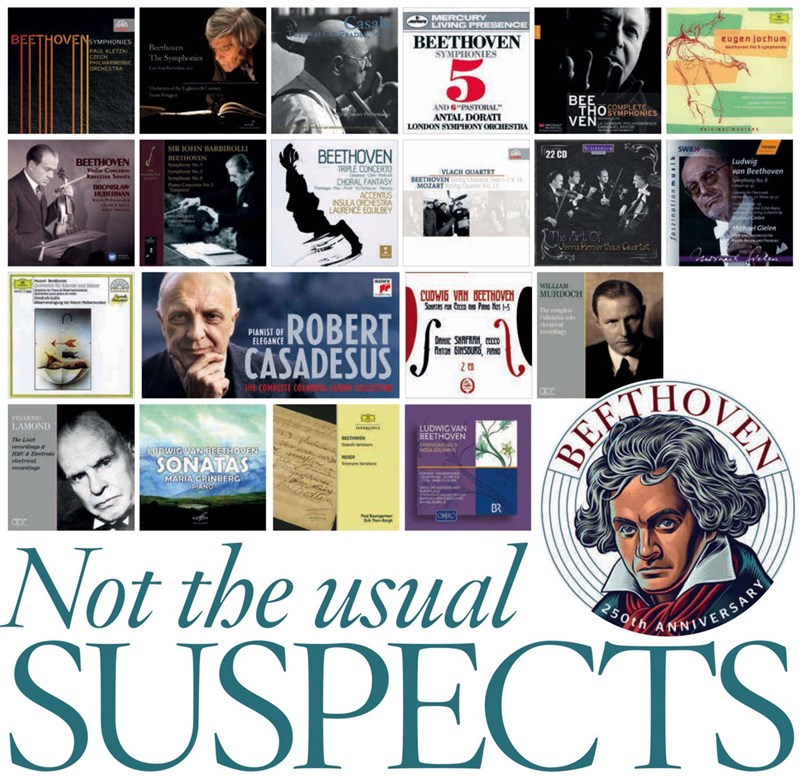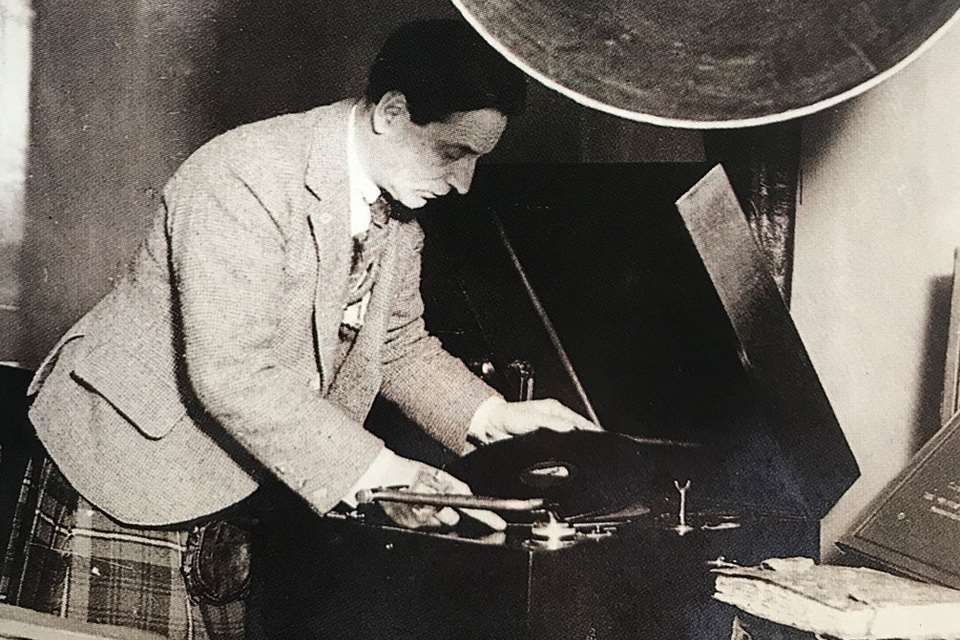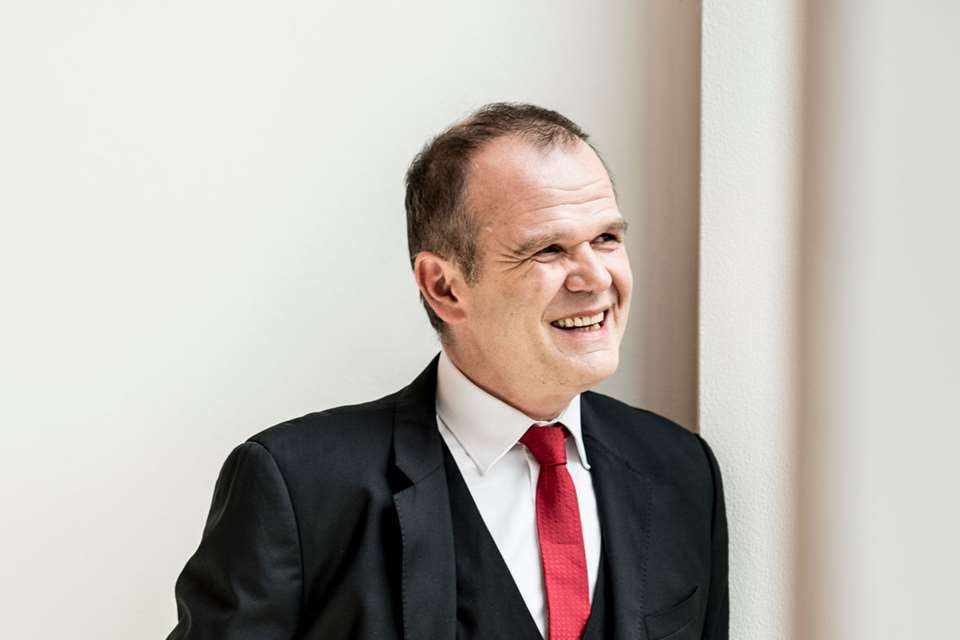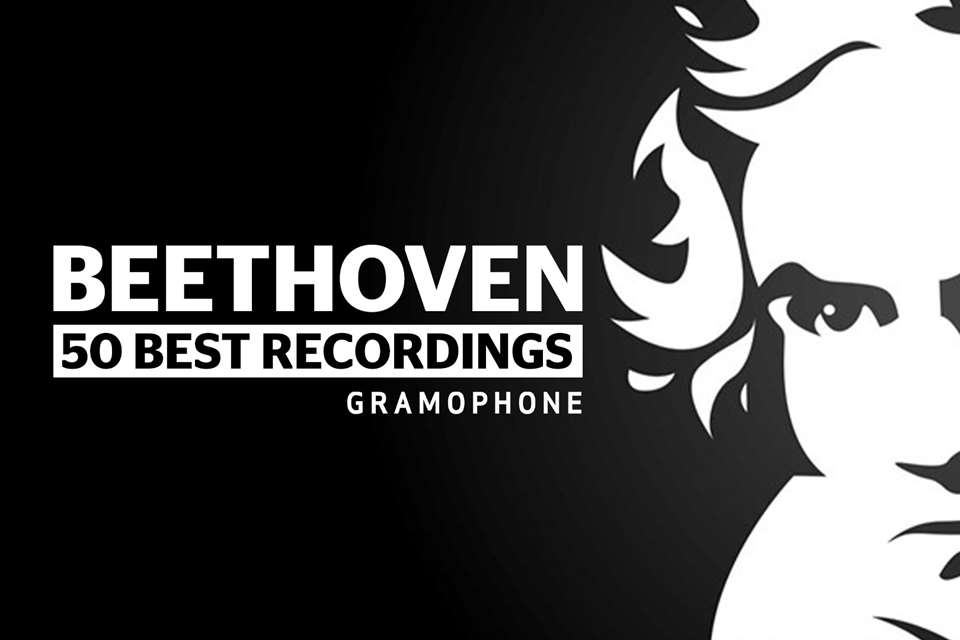Great Beethoven Recordings: Not The Usual Suspects
Rob Cowan
Friday, February 24, 2023
With Beethoven recordings, it’s often the same – justifiably famous – ones that regularly get recommended. We asked Rob Cowan to point us towards others – some of the most inspired and inspiring interpretations you probably haven’t heard

First, I’ll tell you what this piece isn’t. ‘Beethoven’s greatest works’? No, there are too many masterpieces missing for that. ‘The greatest recordings available’? Definitely not that, either. My idea is to sidestep the rightly vaunted Beethoven celebrities (Claudio Arrau, Daniel Barenboim, Leonard Bernstein, Alfred Brendel, Wilhelm Furtwängler, Herbert von Karajan, Wilhelm Kempff, Otto Klemperer, Stephen Kovacevich, Kurt Masur, Roger Norrington, Artur Schnabel, Georg Solti, Arturo Toscanini and so on) and opt instead for names that may have yet to enter your household as Beethoven library fixtures.
And there are so many to choose from. Here is a mere sampling, and a pretty personal one at that. It’s a sad fact of commercial life that the press barely has the chance to assess new releases in relation to what is already available. The most sensible attitude is to give them time to settle, then size them up in relation to the tried and tested. You’ll be amazed how often a not-so-big name faces and triumphs over a much-revered Goliath.
Time and again I’ve thought myself well disposed towards a ‘major’ artist only to be disappointed by a particular reading, which is why nowadays I tend not to favour performers but assess performances in their own right. As far as I know, the recordings discussed here are available either singly or as part of a box-set, often also to stream. Pick a favourite work and test the waters for yourself. You may be pleasantly surprised...
Symphony No 1
Beethoven’s cycle of nine symphonies is, for most music lovers, essential daily nourishment. In No 1, the Czech Philharmonic under Paul Kletzki, as recorded in 1968, presents the aural equivalent of ‘Bohemia’s woods and fields’. Time and again you notice how the delicious Czech Phil woodwind insist themselves onto the canvas, chirruping away, while the strings are razor-sharp in their precision (especially in the finale, once into their stride) and the whole band generates enlivening levels of pooled energy. I’d call this fresh, open-air Beethoven. Of Kletzki’s whole cycle, the first two symphonies are especially good, though the entire thing – which is very well recorded for the period – has many rich ingredients to its credit.
Czech PO / Paul Kletzki (Supraphon, 12/69)
Symphony No 3, ‘Eroica’
Period-performance recordings of the symphonies usually switch to the fast lane, with nifty tempos, transparent textures and a reluctance to bend the musical line. Frans Brüggen’s second cycle with the Orchestra of the Eighteenth Century (his first was for Philips), recorded live in 2011, is the exception that proves the rule. In the Eroica he opts for slower-than-usual tempos, maximum flexibility, a dark overall timbre and impressive depth of tone. The first movement (with repeat) builds as it might have done under Furtwängler or Klemperer, and the ‘Marcia funebre’ is filled with a vivid sense of pathos. It’s ideal for listeners who love old instruments but find their usual manner of employment tiresome.
Orchestra of the Eighteenth Century / Frans Brüggen (Glossa, 1/13)
Symphony No 4
Prior to my hearing Pablo Casals and London Collegium Musicum in this 1959 recording, the top maestro for ushering the darkness of the Fourth Symphony’s Adagio opening into a sunlit Allegro vivace was Furtwängler in wartime Berlin. But Casals’s approach is even more dramatic, with a degree of space that is barely sustainable (though Casals manages to hold the line without allowing it to flag), a mysterious broadening at the centre of the movement, a beautifully drawn account of the second-movement Adagio, a rumbustious Menuetto and a brilliant finale. As ever with Casals, the playing has a real punch to it and although the sound isn’t always ideally clear it’s good enough to convey the basis of a great performance.
London Collegium Musicum / Pablo Casals (Music & Arts)
Symphony No 5
With Beethoven’s Fifth, I’m constantly drawn back to the Mercury version by the LSO under Antal Dorati, recorded in 1962. Why? Because this is a performance without frills or affectations, as muscular and rhythmically assertive as you’ll find anywhere, with gutsy double basses in the Scherzo that in my experience have few, if any, equals on disc (‘Living Presence’ sound helps, of course). Dorati gives you a Beethoven Fifth that’s both direct and uplifting, expressive too – and with integrity to spare. Whenever I hear it (and I’ve heard it many times), it’s as if the ink of Beethoven’s score is still wet on the page.
London Symphony Orchestra / Antal Dorati (Mercury)
Symphony No 6, ‘Pastoral’
Emmanuel Krivine’s 2010 period-instrument Pastoral fits the expected historically informed performance template, but with a difference: here, colour and character abound. The opening does indeed ‘awaken happy feelings’, like a gambolling lamb drunk on morning sunlight, whereas the ‘Scene by the Brook’ is disarmingly gentle (check out the flute from 3'57"). The horns pipe merrily for the gathering country folk, and when it comes to the rhythmically driven storm, the timps (with the expected hard sticks) deliver mightily rolling thwacks, which makes the feelings of thankfulness that follow doubly gratifying. This is a virtual reality Pastoral, with varied weathers that are vivid enough to be imminent.
La Chambre Philharmonique / Emmanuel Krivine (Naïve, 7/11)
Symphony No 9, ‘Choral’
It seems the Choral Symphony’s interpretative options have, over the years, forged a fork in the road somewhere between Toscanini’s clear-headed athleticism and Furtwängler’s more broadly paced flights of mysterious fancy. In 1952, Eugen Jochum and his young Bavarian Radio Symphony Orchestra (and Chorus) teamed up with a quartet of soloists spearheaded from the bass end by Ferdinand Frantz (who offers surely the best ‘O Freunde, nicht diese Töne!’ ever) and recorded a decidedly Furtwänglerian Choral, with some markedly slow tempos, though more keenly inflected than his great predecessor’s performances tended to be. I’d rate this as being among the most visionary Ninths available.
Clara Ebers sop Gertrude Pitzinger contr Walther Ludwig ten Ferdinand Frantz bass-bar Bavarian Radio Chorus and Symphony Orchestra / Eugen Jochum (DG, 10/57)
Violin Concerto
In many key respects, modern approaches to the Violin Concerto have picked up where the Polish virtuoso Bronisław Huberman left off in 1934. Just compare his timing for the first movement (21'10") to, say, Christian Tetzlaff last year (22'45"). Huberman’s first entry boldly rockets us into the ether, his tone throughout is either silvery or acerbic, and his handling of Joachim’s outspoken cadenza is confrontational. Yet there’s warmth aplenty in the Larghetto and the closing Rondo is happily ebullient. It’s interesting that this was George Szell’s only commercial recording of the piece. His pert Viennese accompaniment could hardly have been more consistently on the ball.
Bronisław Huberman vn Vienna Philharmonic / George Szell (Warner Classics, 8/36)
Piano Concerto No 5, ‘Emperor’
When it comes to choices for the Emperor Concerto there is one version that keeps insisting itself into my memory. The pianist, Mindru Katz, actually died on stage while playing Beethoven (a sonata). That was back in 1978, and he was just 52 years old. It’s his recording of the work, made at Manchester’s Free Trade Hall in 1959, that for me best encapsulates the grand, excited, affirmative and perennially fresh spirit of the music. As to the orchestral score, I doubt that the Hallé Orchestra under Sir John Barbirolli ever made a more vital Beethoven recording than this. It’s as if all and sundry are literally shouting the music from the rooftops.
Mindru Katz pf Hallé Orchestra / John Barbirolli (Barbirolli Society, 7/59)
Triple Concerto
The Triple Concerto is in essence fleshed-out chamber music, which is why the admittedly handsome Oistrakh–Rostropovich–Richter–BPO–Karajan version (Warner Classics) tends to misfire. In their 2018 recording, Laurence Equilbey and her lissom team opt for a lighter, more dynamic, more muscular and – where needs be – more intimate approach. Full forte chords really register (the timps are magnificently present), both string players make colour a priority while pianist David Kadouch is extremely nimble and the chosen tempos are ideal throughout. This is ‘feel-good’ Beethoven, light years removed from the scowling revolutionary, and even more pastoral than the Pastoral Symphony itself. It’s no good trying to turn it into what it isn’t.
Alexandra Conunova vn Natalie Clein vc David Kadouch pf Insula Orchestra / Laurence Equilbey (Erato, 5/19)
String Quartet No 14, Op 131
You might say that the opening fugal Adagio ma non troppo e molto espressivo of Beethoven’s C sharp minor String Quartet revolutionised the quartet medium as much as Wagner’s Tristan chord altered the course of orchestral music. Both usher us among loaded shadows, but with Beethoven the eventual transformation to allegro signals a breaking dawn. And while the Busch, Budapest and Juilliard quartets focus most aspects of this wonderful music virtually to perfection, the Vlach Quartet’s candid approach (in 1960) – so vibrantly emotional and yet so controlled – perhaps provides the ideal boarding point for the uninitiated. The variation movement becomes an ever-changing prism, the scherzo is full of mischief and the finale vividly suggests the strutting, square-jawed master in full creative flight.
Vlach Quartet (Supraphon, 8/62)
String Quartet No 15, Op 132
Although great beyond measure, Beethoven’s late quartets are problematic in that their ethereal nature makes them peculiarly difficult to grasp, even in the most inspired performances. The beauty of this 1951 recording of Op 132 by the Vienna Konzerthaus Quartet is that a sense of spiritual levitation (such as you experience in the ‘thanksgiving’ episodes in the Molto adagio) is never indulged at the expense of the music’s overall structure. The second movement’s musette-like middle section is charming, and the last two movements, a bracing march and an impassioned allegro, suggest a decisive sense of closure. It’s the solidity of this performance that most appeals, allied to its intensity and Viennese warmth.
Vienna Konzerthaus Quartet (Scribendum, 5/18)
Grosse Fuge (arr Gielen)
Michael Gielen was best known for his probing accounts of modern music. In the classics, that same level of creative intuition (Gielen was himself an accomplished composer) encouraged you, the listener, to freshly re-evaluate whatever you were hearing. For his version of Beethoven’s Grosse Fuge (a work that Stravinsky once described as ‘an absolutely contemporary piece of music that will be contemporary forever...’), Gielen’s implied point is that if you’re going to make chamber music symphonic, you must make it sound symphonic. Rarely has this intellectually challenging monolith been greeted with so many varieties of attack and articulation, as novel as they are fascinating. This 1993 recording will hold you in thrall, I guarantee.
SWR SO Baden-Baden and Freiburg / Michael Gielen (Hänssler Classic, 11/02)
Quintet for Piano and Winds
Beethoven’s delightful Op 16 is available either for piano and winds (a quintet, as here) or as a quartet for piano and strings. Friedrich Gulda and his Vienna Philharmonic colleagues (recorded in 1960) achieve a perfect tonal blend, warm yet with a refreshing edge to the sound; and the performance is elegant, graceful and extremely well drilled. The outer movements are both marked Allegro ma non troppo, which – if the performers are sympathetic – confirms the music’s genial mood. The lovely central Andante cantabile finds these attentive performers ideally responsive. Altogether, this is a joy to listen to, and the coupled Mozart quintet (K452) is just as good.
Friedrich Gulda pf Vienna Philharmonic Wind Ensemble (DG, 3/61)
Violin Sonata No 9, ‘Kreutzer’
The fabled partnership of Zino Francescatti and Robert Casadesus recorded the Kreutzer Sonata twice for CBS: once in New York in 1949 (mono) then in Paris in 1958 (stereo). Both versions are included in the large Casadesus box-set released by Sony Classical last year. The later version, although conceptually compelling, finds Francescatti’s febrile tone and nervy vibrato just a little overbearing, while the sound brings Casadesus’s contribution too much to the fore. By contrast, the earlier version is better balanced as well as more nuanced as an interpretation, with numerous subtleties from both players. There’s no first-movement repeat (on either version), but such is the intensity – and brilliance – of the playing, that everything registers first time round.
Zino Francescatti vn Robert Casadesus pf (Sony Classical, 9/54)
Cello Sonata No 5
Daniil Shafran commanded the widest range of colours and dynamics of any cellist in living memory (I was lucky enough to have caught his last London recital, an event largely facilitated by Steven Isserlis). His 1971 set of the Beethoven sonatas with Anton Ginsburg says it all, especially the great last sonata: whether he’s murmuring quietly, parading that signature fulsome vibrato (especially when on the attack), blissfully singing (try from 5'25" into the first movement), darkening his tone for the Adagio con molto sentimento d’affetto or edging craftily into the closing Allegro fugato – a marvellous effect. Ginsburg proves an ideal duo partner and the recording reports a truthful balance between the two players.
Daniil Shafran vc Anton Ginsburg pf (Melodiya, 6/16)
Piano Sonata No 8, ‘Pathétique’
Many years ago when I used to visit London market stalls in search of classical 78s (principally piano records by Friedman, Rosenthal, Horowitz, Rachmaninov and the like), I chanced upon a 1926 version of the Pathétique Sonata by one William Murdoch, who on further exploration turned out to be an Australian pianist, composer and author. What I didn’t know as I ferried my bundle of discs back home was that I’d just purchased the most exciting version of the Pathétique Sonata ever recorded (a claim that still holds), with the first-movement Allegro di molto e con brio ferocious in its attack (with pitch-black Grave passages for contrast), an earnestly poetic Adagio cantabile and a spirited closing Rondo.
William Murdoch pf (APR, A/19)
Piano Sonata No 17, ‘Tempest’
Regarding his Piano Sonata No 17, Beethoven is reputed to have said to his close friend Anton Schindler, ‘If you want to know what the music means, read Shakespeare’s The Tempest.’ Its opening movement features violently contrasting dynamics and tempos as well as two passages of recitative which are deliberately blurred through the use of the sustaining pedal. But it’s the finale that’s perhaps the most remarkable aspect of this 1927-28 recording by the Glasgow-born Liszt pupil Frederic Lamond, who even as late as 1945 (when he was in his mid-seventies) was still being billed as ‘the greatest living exponent of Beethoven’. The playing here, so relaxed and yet so full of character, draws me back time and again.
Frederic Lamond pf (APR, 8/30)
Piano Sonata No 29, ‘Hammerklavier’
Maria Grinberg was the first Soviet pianist to record all 32 Beethoven sonatas. Grinberg, like so many of her musician-compatriots, had born the weight of personal tragedy: both her husband and her father were arrested and executed as ‘enemies of the people’. But she rallied on in spite of this, her playing always forceful and intellectually compelling, and never more so than in the Hammerklavier Sonata (1966), where in addition to parading the necessary pianistic brawn she draws virtually as much poetry from the Adagio sostenuto as does Schnabel on his famous pre-war HMV recording. The flexibility of her reading is remarkable.
Maria Grinberg pf (Melodiya/Scribendum, 4/13)
Diabelli Variations
How do you interpret a work that is so jam-packed with invention that there seems little room to supplement Beethoven’s dazzling array of ideas with interpretative ideas of your own? In his 1952 recording, pianist Paul Baumgartner opts to tell it as it is, journeying from one variation to the next with absolute naturalness – be it from the fast opening theme to the Alla marcia maestoso that follows, from the galloping Variation 15 to the boogie-like Var 16 or the humbling sequence of three variations that brings the work to its close, leading us to a vast precipice before Beethoven summarily dispatches us with an elegant minuet and a 19th-century equivalent of ‘that’s all folks’. If ever genius was made manifest in music, it’s here.
Paul Baumgartner pf (DG, 9/17)
Missa solemnis
Next to the Grosse fuge and the Diabelli Variations, the Missa solemnis has to rate as being among the greatest of Beethoven’s stand-alone masterpieces (that is, those that are not part of a cycle). Rather than suggesting a specific place of worship, the Missa solemnis brings prayer and thanksgiving into the open air, where towards the end of the Agnus Dei even auguries of battle are audible. Had Furtwängler recorded the work, I’ve a feeling that his viewpoint would have tallied with Rafael Kubelík’s from 1977 – with its mastery of transitions, humbling sense of scale and engagement with that unnameable ‘something’ that even the non-believer might feel in the face of such an overwhelming listening experience.
Helen Donath sop Brigitte Fassbaender mez Peter Schreier ten John Shirley-Quirk bass-bar Bavarian Radio Symphony Chorus and Orchestra / Rafael Kubelík (Orfeo, 8/19)
Life is better with great music in it. Subscribe to Gramophone today














